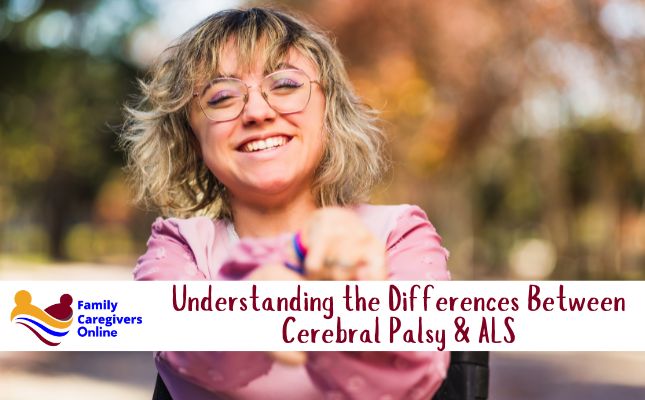


Cerebral palsy (CP) and amyotrophic lateral sclerosis (ALS) are two conditions that affect movement and muscle control, but they are very different in their causes, progression, and the type of care required. Understanding these differences can help caregivers provide the right support and plan for long-term needs.
Cerebral palsy is a neurological disorder that often begins before or during birth, usually caused by brain damage. It impacts muscle tone, posture, and coordination. In many cases, early detection through screenings and tests can help families create a care plan that addresses developmental needs and maximizes future independence. Meanwhile, ALS, sometimes called Lou Gehrig’s disease, usually starts later in adulthood and progresses quickly. According to the ALS Association, it causes muscle weakness, trouble speaking, and eventually impacts breathing.
How Cerebral Palsy and ALS Differ
While both conditions affect motor function, the way they appear and develop is very different. Cerebral palsy is considered non-progressive, meaning the brain injury does not worsen over time, although symptoms can change as a child grows. On the other hand, ALS is a progressive disease that steadily gets worse, leading to increasing disability. As Project ALS highlights, most people diagnosed with ALS live two to five years after symptoms begin, though research continues to search for treatments that can improve outcomes.
Another major difference is the age of onset. Cerebral palsy is often diagnosed in infancy or early childhood, while ALS typically shows up between the ages of 40 and 70. Treatment goals also differ: cerebral palsy management focuses on maximizing independence through therapies and assistive devices, while ALS care often centers around maintaining quality of life as the disease advances.
Caregiving for Cerebral Palsy vs. ALS
Providing care for someone with cerebral palsy often starts early and can last a lifetime. Caregivers might help with daily tasks, therapy appointments, mobility support, and educational needs. Over time, many individuals with CP achieve a high degree of independence, especially with the help of assistive technology designed to support movement, communication, and daily activities.
Caregiving for someone with ALS tends to be more intense and time-sensitive. As ALS progresses, caregivers may assist with mobility devices, feeding tubes, speech aids, and breathing support. The ALS Therapy Development Institute offers helpful guidance and resources for caregivers who often face rapidly changing needs over months or even weeks.
Both caregiving roles can be rewarding and deeply meaningful, but also physically and emotionally demanding. Caregivers may find it helpful to connect with organizations like the Family Caregiver Alliance, which offers education, emotional support, and planning tools for those caring for loved ones with chronic conditions.
Treatment and Support Options
Although there is no cure for either cerebral palsy or ALS, different treatment strategies aim to improve comfort, mobility, and quality of life. Children with cerebral palsy may benefit from a range of therapies, including physical therapy, occupational therapy, and sometimes orthopedic surgery. Many families turn to professional guidance from organizations like the American Physical Therapy Association to tailor interventions that promote independence and participation in daily activities.
For individuals with ALS, treatment often includes medications like Riluzole and Radicava, which may slow progression slightly. Care plans frequently involve speech therapy, respiratory support, and palliative care to help manage symptoms and maintain dignity through all stages of the disease.
A Note on ALS Awareness Month
Every May, communities across the country recognize ALS Awareness Month. This is a time to increase public understanding of the disease, honor those living with ALS, and advocate for continued research and support services. Spreading awareness can help improve early diagnosis, expand funding for treatment research, and provide caregivers with the resources they need. Families and individuals can get involved by participating in ALS walks, sharing stories, or supporting organizations dedicated to finding a cure.


Summary
Caring for someone with cerebral palsy or ALS requires compassion, flexibility, and patience. Whether starting a lifelong journey with a child diagnosed with CP or supporting a loved one through the progression of ALS, caregivers play a vital role in promoting comfort, connection, and dignity. By understanding the differences between these conditions and accessing available resources, caregivers can help their loved ones live fuller, more supported lives.
Source: ALS.org & Jennifer LaRocco, Editor, Cerebral Palsy Guidance
We hope this information is helpful to you in the important work you do as a family caregiver.
For more resources, subscribe to our free newsletter!








